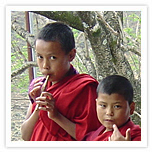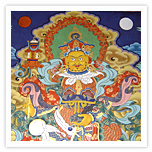Tours to Bhutan, Travel to Bhutan
- Bhutan Visitor Info
- Western Region Bhutan -
- Central Region Bhutan -
- Eastern Region Bhutan -
- Festivals of Bhutan -
- National symbols -
- History of Bhutan -
- Culture of Bhutan -
- Religion of Bhutan -
- People of Bhutan -
- Bhutan Visa & Customs -
- Bhutan Accommodation -
- Bhutan Transportation -
- Climate of Bhutan -
- Currency of Bhutan -
- Paro Festival Bhutan -
- Trekking in Bhutan -
Culture of Bhutan
For further Details Contact Us
 The
culture of Bhutan is among the oldest in the world - carefully guarded and
well preserved.
The
culture of Bhutan is among the oldest in the world - carefully guarded and
well preserved. PEOPLE: Bhutan essentially has three main ethnic groups: the Sharchop in the east, who originated from the tribes of northern Burma and northeast India; the Ngalops in the west, who introduced Buddhism to Bhutan after migrating from Tibet; and the Lhotsampas in the south, originally belonging to Nepal. The overall population of Bhutan is around 700,000.
Thimphu, the capital of Bhutan, is one of the large towns in Bhutan. Farming is the main occupation of the people of Bhutan, who live in small rural villages. Most of these villages are secluded and even in the modern world of today, are accessible only by foot. But some people, with the help of education, are migrating to towns in search of other occupations.
LANGUAGE: Dzongkha is the official language of Bhutan, but many regions in Bhutan still retain their native dialects due to their isolation. Apart from Dzongkha, English remains the only other medium of instruction in Bhutan.
RELIGION: The Tantric form of Mahayana Buddhism is the official religion of Bhutan. It is an important factor in the development of Bhutanese society. Villages in Bhutan are strewn with temples and religious structures, which are present along the roads and trails. One can also see many prayer flags on the hills and high passes, fluttering in the breeze. Almost every home in Bhutan has a special area called a chosum, which is a small shrine, or a special room used for prayers.

ARCHITECTURE: Traditionally Bhutanese houses are made out of mud, bamboo, and wood. The doors and windows of Bhutanese houses are decorated with animal, religious, or floral designs. The houses usually consist of three stories. The cattle and other animals of the house reside on the ground floor, the second floor is for storage, and on the third floor are the living quarters, which often also have the shrine (i.e. Chosum). Hay, dry vegetables and meat are stored in the open-air between the third floor and the roof. The most important feature of Bhutanese houses is the prayer flag placed in the centre of the roof.
Bhutanese architecture is characterized by structural designs and exterior paintwork (shapes, colors, and patterns), representing national identity and traditional meanings. Dzongs (fortresses), Gompas (monasteries), Chortens (shrines/stupas), Lakhangs (temples) and houses are some of the impressive and important structures in Bhutan. Most of the monasteries and temples throughout Bhutan are built on steep hillsides and in other remote places. This ensures that the monks get solitude and serenity. All the monasteries in Bhutan have some common features though they also have their own design. Monasteries here have a central chapel with statues and separate sleeping quarters for the monks. There are prayer wheels around the outside and a round gold-coloured ornament on the roof. Temples are not very different from monasteries in design and look; the only difference between them is that they do not house monks.
 DRESS: The national dress of Bhutan originated from the time of the
first Shabdrung. The men in Bhutan wear a "gho," a long
knee-length robe that is tied around the waist by a belt and the women wear
a "kira," which is an ankle-length dress worn with a short jacket.
To preserve the ancient customs from being influenced by the West, the
Bhutanese government has made it compulsory for all Bhutanese to wear only
their national dress in public.
DRESS: The national dress of Bhutan originated from the time of the
first Shabdrung. The men in Bhutan wear a "gho," a long
knee-length robe that is tied around the waist by a belt and the women wear
a "kira," which is an ankle-length dress worn with a short jacket.
To preserve the ancient customs from being influenced by the West, the
Bhutanese government has made it compulsory for all Bhutanese to wear only
their national dress in public. SPORT: Bhutan's national sport is Archery, which is played here with unique Bhutanese rules and equipment. The traditional bows and arrows are made out of bamboo and the teams of archers shoot at targets with amazing precision from a good distance.
FOOD: The Bhutanese diet is rich in meat and poultry, dairy, grain and vegetables. Rice and chillies are the major features of Bhutanese diet. Emadatse (chilly pepper and cheese stew) is considered the national dish with many interpretations of this recipe throughout the country. Poultry and meat dishes, pork, beef and yak, are lavishly spiced with chillies, and it is common to see bright red peppers drying on rooftops in the sun. Salted butter tea, or suja, is served on all social occasions. Chang, a local beer, and arra, a spirit distilled from rice, maize, wheat or barley, are also common and widely favoured. Doma or betel nut is offered as a customary gesture of greeting. The chillies are considered a vegetable and not just a spice. Bhutanese dishes are mostly fiery but uniquely Bhutanese in every sense.






